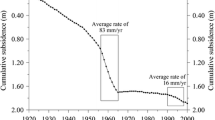Abstract
Groundwater levels at Downie Slide have varied during the development of and over the operating life of the Revelstoke Reservoir. Drainage system construction successfully lowered groundwater levels through the central portion of the slope; reservoir filling resulted in water table rise near the inundated toe, and over the operating life of the hydro-electric facility gradual, minor losses to the drainage system capacity have resulted in a slow rise in water table levels. Calibrated models capable of reproducing observed deformation patterns at Downie Slide have been tested with changing groundwater levels. Models perform well, adequately reproducing observations of global slope response to changes in piezometric boundary conditions. These models have also been used to test potential trigger scenarios, including rapid reservoir drawdown and a total loss of drainage system capacity.














Similar content being viewed by others
References
Barla G, Antolini F, Barla M, Mensi E, Piovano G (2010) Monitoring of the Beauregard landslide (Aosta Valley, Italy) using advanced and conventional techniques. Eng Geol 116:218–235
Bourne D, Imrie A (1981) Revelstoke project Downie slide investigations report on 1981 drill program. BC hydro report number 1469, pp 1–14
Bourne DR, Imrie AS, Wade MD (1978) Downie slide investigations report on 1976–1977 field work. B.C. Hydro Hydroelectric Generation Projects Division. Report no. HE.C. 925
Brown RL, Psutka JF (1980) Structural and stratigraphic setting of the Downie slide, Columbia River valley, British Columbia, Canadian. J Earth Sci 17:698–709
Cappa F, Guglielmi Y, Soukatchoff VM, Murdry J, Bertrand C, Charmoille A (2003) Hydromechanical modelling of a large moving rock slope inferred from slope leveling coupled to spring long-term hydrochemical monitoring: example of the La Clapière landslide (Southern Alps, France). J Hydrol 291:67–90
Crosta GB, Agliardi F (2003) Failure forecast for large rock slides by surface displacement measurements. Can Geotech J 40:176–191
Enegren EG (1995) Reassessment of the static stability analysis of Downie slide 1994. BC hydro report number H2889, pp 1–55
Enegren EG, Imrie AS (1996) Ongoing requirements for monitoring and maintaining a large remediate rockslide. In: Proceedings of the 7th international Symposium on landslides, pp 1677–1682
Gerraghty D, Lewis M (1983) Downie slide field report on contract CR-10A geology and construction. B.C. Hydro and Power Authority
Golden Software Inc. (2002) Creating grid files. In: Surfer 8 contouring and 3D surface mapping for scientists and engineers user’s guide. Golden Software, Inc.. Golden, Colorado, USA, pp 89–162
Hendron AJ, Patton FD (1987) The Vaiont Slide—a geotechnical analysis based on new geological observations of the failure surface. Eng Geol 24:474–491
Imrie AS, Moore DP, Enegren EG (1991) Performance and maintenance of the drainage system at Downie Slide. In: Proceedings of the 6th international symposium on landslides, pp 751–757
Itasca Consulting Group Inc. (2003) 3DEC 3 dimensional distinct element code: theory and background. Excerpts from version 3.0 program manual
Jory LT (1974) Appendix 2 summary of geology. In: Revelstoke project Downie slide investigations summary of 1973 exploration program. BC hydro report no. 725, pp 1–8
Kalenchuk KS, Hutchinson DJ, Diederichs MS (2009a) Downie slide–interpretations of complex slope mechanics in a massive, slow moving, translational landslide. In: Proceedings of GeoHalifax2009—Canadian geotechnical conference, pp 367–374
Kalenchuk KS, Hutchinson DJ, Diederichs MS (2009b) Application of spatial prediction techniques to defining three-dimensional landslide shear surface geometry. Landslides 6:321–333
Kalenchuk KS, Hutchinson DJ, Diederichs MS (2010) Morphological and geomechanical analysis of the Downie slide using 3-dimensional numerical models: testing the influence of internal shears and interaction between landslide regions on simulated slope behaviour. Submitted to Landslides in August: 26 manuscript pages
Kalenchuk KS, Diederichs MS, Hutchinson DJ (2012) Three-dimensional numerical simulations of the Downie Slide to test the influence of shear surface geometry and heterogeneous shear zone stiffness. Comput Geosci 16:21–38
Miller SM, Barla G, Piovano G, Barla M (2008) Geotechnical and temporal risk assessment of a large slope deformation. In: Proceedings of the 42nd US rock mechanics symposium and 2nd US-Canadian rock mechanics symposium, 8 pp
Nordvik T, Nyrnes E (2009) Statistical analysis of surface displacements—an example from Ǻknes rockslide, western Norway. Nat Haz Earth Syst Sci 9:713–724
Rat M (1995) The landslide at La Clapière—monitoring and prediction of failure. Felsbau 3(6):420–424
Semenza E, Ghirotti M (2000) History of the 1963 Vaiont Slide: the importance of geological factors. Bull Eng Geol Env 59:87-97
Smith WHF, Wessel P (1990) Gridding with continuous curvature splines in tension. Geophys 55:293–305
Wheeler JO (1965) Big Bend map-area, British Columbia (82 M east half). Geol Surv Can Paper 64–32:1–37
Acknowledgments
The authors would like to thank BC Hydro, particularly the late John Psutka and Dennis Moore, for site and data access. This work has been made possible through contributions by NSERC, CFI and GEOIDE.
Author information
Authors and Affiliations
Corresponding author
Rights and permissions
About this article
Cite this article
Kalenchuk, K.S., Hutchinson, D.J. & Diederichs, M.S. Downie Slide: numerical simulation of groundwater fluctuations influencing the behaviour of a massive landslide. Bull Eng Geol Environ 72, 397–412 (2013). https://doi.org/10.1007/s10064-013-0484-5
Received:
Accepted:
Published:
Issue Date:
DOI: https://doi.org/10.1007/s10064-013-0484-5




